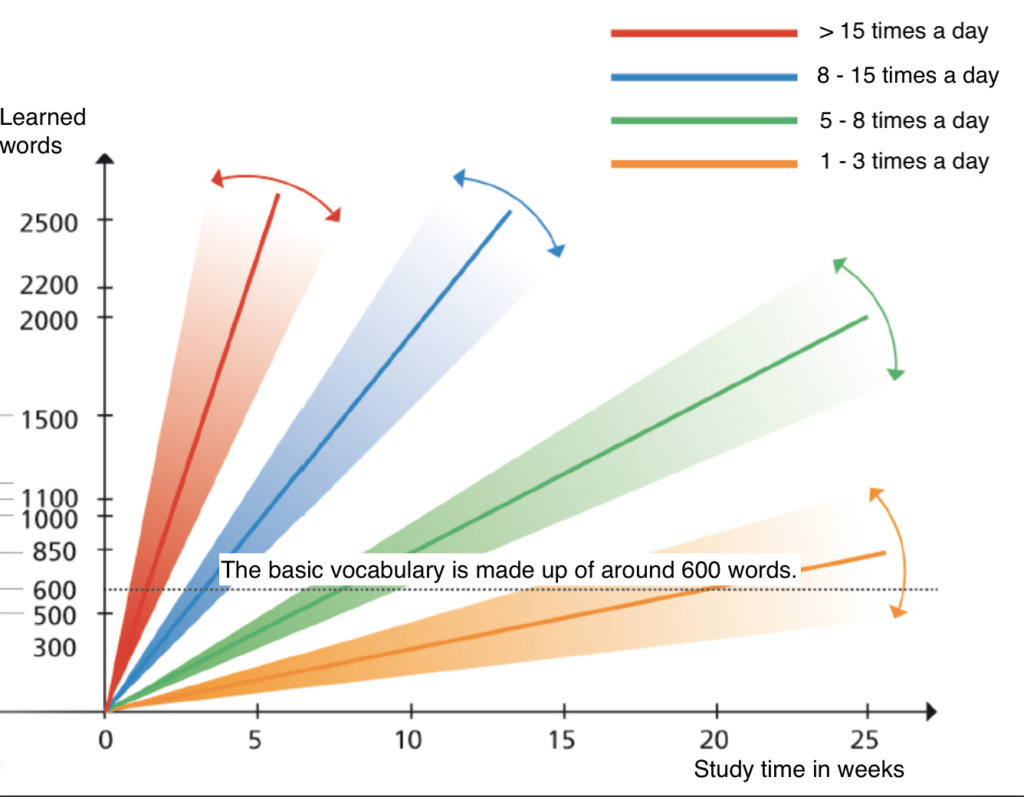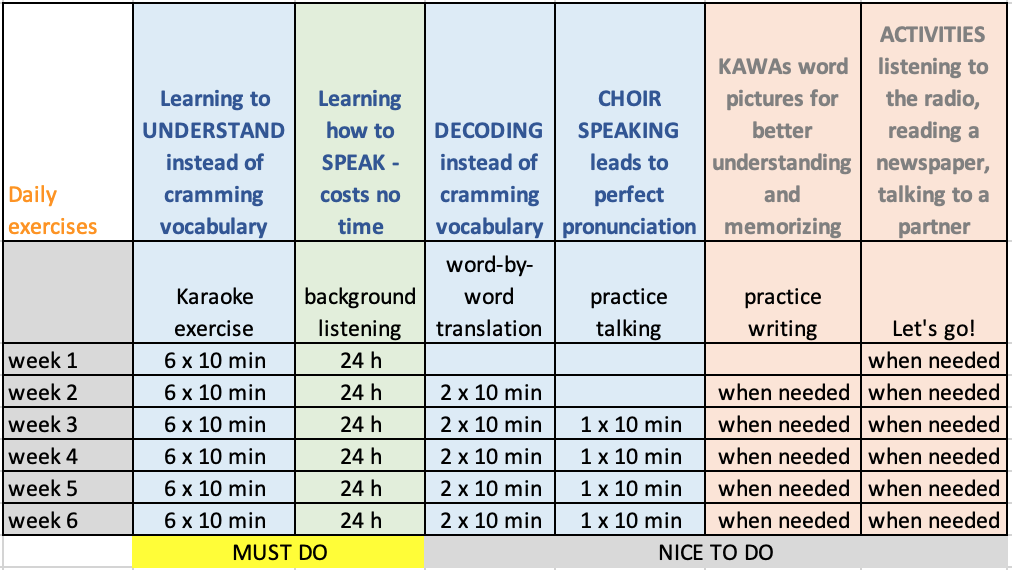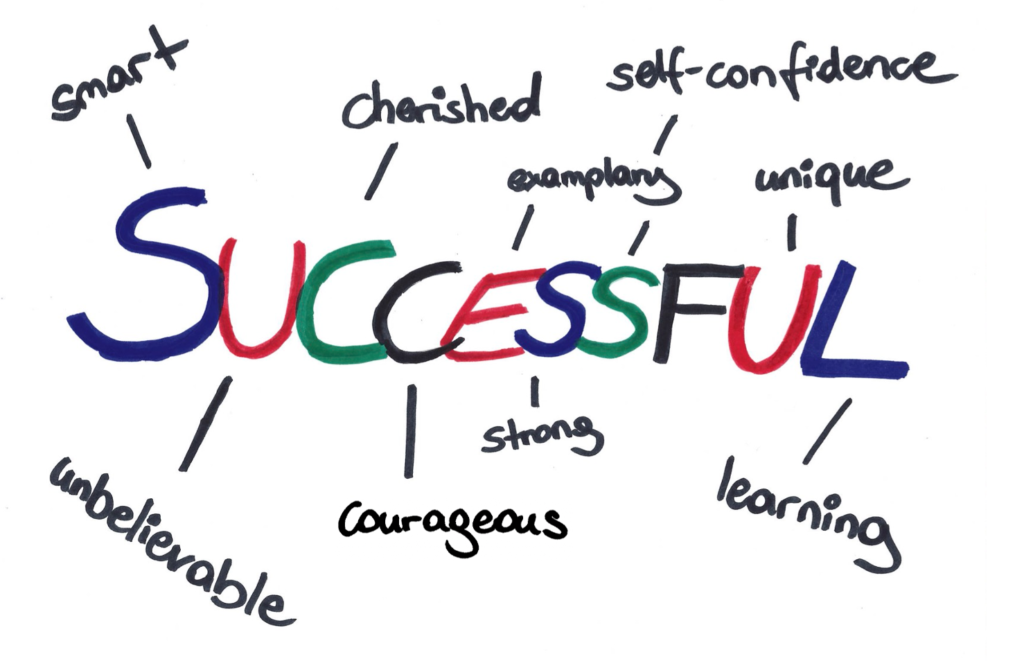The Rule of 6
Do you know the Rule of 6? This rule calculates in unique words. The rule says that you can learn 600 unique words in only six weeks. This number is higher than the number of unique terms used by the most widely circulated newspapers.
You can achieve this goal by spending six times 10 minutes a day.

Your 6-week learning plan could look like this:

WEEK 1 to 6: LEARNING TO UNDERSTAND
By listening to the foreign language and reading the word-by-word translation (decoding), you will learn to understand the foreign language. We also call this the karaoke exercise. This exercise is the principle of the Birkenbihl Approach and the foundation of all brain-friendly MOVIE© language courses.
The karaoke exercise replaces boring vocabulary cramming. By implementing the activities in 10-minute units, you almost double the learning speed. Work through the lessons chronologically and repeat the lessons until you understand the meaning of the words. See the table above for our recommendation on how to break down the exercises best.
You can find more details about LEARNING TO UNDERSTAND here: The Birkenbihl Approach.
WEEK 1 to 6: LEARNING TO SPEAK by PASSIVE LISTENING
When you listen to a text you already know and understand repeatedly (preferably on a continuous loop for 24 hours, quietly in the background), we call this “passive listening” – or, so to speak, BACKGROUND LISTENING. Play the audio of the lessons you started the LEARNING TO UNDERSTAND with, and then add each additional class you already understand.
Just like going abroad, you will be continuously surrounded by a foreign language. In the process, the brain creates the necessary neural pathways to speak the text perfectly afterward. The subconscious is therefore working for you – it processes what you have already learned. This process is best demonstrated by children who intuitively pick up their native language from their surroundings.
Background listening simulates the stay abroad. In this way, you learn to speak the foreign language correctly and without wasting time.
In other words, if you already understand the text of your audiobook, you will learn to speak it through “passive listening.” You will get the best results if you do Passive Listening day and night. You should adjust the volume so that you can concentrate on other things in your daily life without being disturbed. You learn while working, cooking, driving, watching TV, listening to the radio, or even reading the newspaper.
WEEK 2 to 6: DECODING – a word-by-word translation:
The brain-friendly exercises are built on a two-line text. On top, the foreign language – below, the word-by-word translation into the native language. You can decode any text yourself and thus, for example, catch up on missed lessons or learn specialized vocabulary.
Decoding provides two significant advantages:
- Vertically (from top to bottom), you learn the meaning of words. This replaces mindless vocabulary cramming, and you understand the language holistically and intuitively!
- Horizontally (from left to right), you learn the language structure, i.e., the grammar. And this automatically – without knowing any rules! Through the support of the translations, you open your brain to the “view” of the rules of the foreign language.

Then practice decoding if you don’t remember specific passages or use the practice forms (printouts provided with each brain-friendly language course) to decode the entire lesson’s entire content. Decoding is an option that some people progress exceptionally quickly with; others progress more rapidly with the karaoke exercises. You don’t necessarily have to decode!
How does decoding work?
You translate a two-line text word-by-word into the native language. Ensure that the meaning of the sentence is still easily recognizable – so translate in the context of the sentence. This includes translating case affinities and conjunctions, etc. In the beginning, this is a bit unfamiliar, but it opens up your view regarding the language and the culture behind it.
Very soon, it seems like solving puzzles and starts to be more and more fun. And you learn the meaning of the words along the way. This is especially fun in a study group and resembles a city-country-river game. This way, you can bring students and adults to a foreign language with fun and joy.

Songs or excerpts from daily newspapers are very suitable for such decoding. As a beginner, you can decode about two sentences in 10 minutes.
Work on your technical terms with decoding exercises from specific books or magazines.
WEEK 3-6: ADDITIONAL CHORAL SPEAKING
Choral speaking is one of the exercises that automatically corrects deviations in your pronunciation by imitating the speaker, thus leading you into “harmony” with the speaker (you know this from religions). In this process, the subconscious mind checks your speech and the speaker’s speech and compensates for differences on its own. If perfect pronunciation is your primary goal, then you should do this exercise more often.
My tip: Do it in addition to the six times 10 minutes a day. If you can’t find the extra time, replace a decoding exercise or a karaoke exercise with a CHORAL SPEAKING exercise.
For the exercise, you will need an audio recording of a foreign language text that you already know and understand (e.g., through decoding) and have PASSIVELY listened to.
As the name implies, in choral speaking, you speak “in a choir” – you and the recording speaker.
With the brain-friendly language courses, you can implement choral speaking very well with the karaoke player. To do this:
- Start the video and read the text aloud.
- In the beginning, adjust the speaker’s volume so that it is about as loud as you are speaking.
- Do this exercise until you notice that you are becoming more confident.
After a few repetitions, turn down the volume of the computer. In time, you will no longer need the speaker because your pronunciation will be perfect.
WEEK 2-6 (as needed): KAWAs
Supplement UNDERSTANDING exercises with KAWAs. Through this exercise, you will practice writing the language and connect what you have learned with what you have already learned.
KAWAs are creative word associations used in many areas of life. In language learning, we recommend creating KAWAs of words you don’t remember or words with multiple meanings.
Write a word in large letters on a piece of paper. Now look at the word – find associations to its letters. Write down what comes to your mind first. You can write down several words per letter or leave gaps. Do this for 90 seconds per word.
With the power of the visual, you will find learning more comfortable. Also, we “hang” associations in our brain with the first letter, making it easier for us to “recall.” Existing information can thus be summarized and repeated.

WEEK 1-6: ACTIVITIES!
The learning progress is tremendously fast! Use every opportunity to improve the knowledge you have already built up. Listen to the radio in a foreign language, pay attention to the lyrics in music tracks, and try to establish a conversation if you meet a native speaker. You will be amazed at how much you already understand and can speak yourself!
Finally, two tips for you:
- Keep going! The brain knows no weekend! Use it or lose it is the motto here. Even if some days are packed with other things – train at least 10 minutes daily! This consistency will show your brain that you are sticking to it!
- Repeat each lesson at least 3 times! Because we lose about 40% of what we have learned or heard after only 20 minutes.
